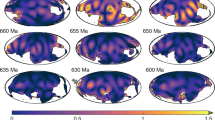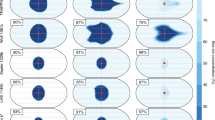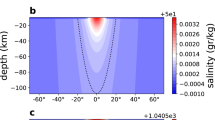Abstract
THERMODYNAMIC and photochemical arguments1–4 suggest that Titan, the largest satellite of Saturn, has a deep ocean of liquid hydrocarbons. At visible wavelengths, Titan's surface is obscured by a thick stratospheric haze, but radar observations5–7 have revealed large regions of high surface reflectivity that are inconsistent with a global hydrocarbon ocean. Titan's surface has also been imaged at infrared wavelengths8–10, and the highest-resolution data (obtained by the Hubble Space Telescope) show clear variations in surface albedo and/or topography10. The natural interpretation of these observations is that Titan, like the Earth, has continents and oceans. But Titan's high orbital eccentricity poses a problem for this interpretation, as the effects of oceanic tidal friction would have circularized Titan's orbit for most configurations of oceans and continents1,11. Here we argue that a more realistic topography, in which liquid hydrocarbons are confined to a number of disconnected seas or crater lakes, may satisfy both the dynamical and observational constraints.
This is a preview of subscription content, access via your institution
Access options
Subscribe to this journal
Receive 51 print issues and online access
$199.00 per year
only $3.90 per issue
Buy this article
- Purchase on Springer Link
- Instant access to full article PDF
Prices may be subject to local taxes which are calculated during checkout
Similar content being viewed by others
References
Sagan, C. & Dermott, S. F. Nature 300, 731–733 (1982).
Flasar, F. M. Science 221, 55–57 (1983).
Lunine, J. I., Stevenson, D. J. & Yung, Y. K. Science 222, 1229–1230 (1983).
Lunine, J. I. Rev. Geophys. 31, 133–149 (1993).
Muhleman, D. O., Grossman, A. W., Butler, B. J. & Slade, M. A. Science 248, 975–980 (1990).
Muhleman, D. O., Grossman, A. W., Slade, M. A. & Butler, B. J. (abstr.) Bull. Am. astr. Soc. 24, 954–955 (1992).
Grossman, A. W. & Muhleman, D. O. (abstr.) Bull. Am. astr. Soc. 24, 954 (1992).
Lemmon, M. T., Karkoschka, E. & Tomasko, M. Icarus 103, 329–332 (1993).
Griffith, C. A. Nature 364, 511–514 (1993).
Smith, P. H., Lemmon, M. T., Caldwell, J. J., Allison, M. D. & Sromovsky, L. A. (abstr.) Bull. Am. astr. Soc. 26, 1181 (1994).
Sears, W. D. (abstr.) Bull. Am. astr. Soc. 26, 1184 (1994); Icarus (in the press).
Lambeck, K. The Earth's Variable Rotation: Geophysical Causes and Consequences 295 (Cambridge Univ. Press, Cambridge, 1980).
Webb, D. J. Contemp. Phys. 23, 419–442 (1982).
Burns, J. A. in Satellites (eds Burns, J. A. & Matthews, M. S.) 117–158 (Univ. Arizona Press, Tucson, 1986).
Dermott, S. F. Icarus 37, 310–321 (1979).
Smith, B. A. et al. Science 212, 163–191 (1981).
Engel, S., Hartmann, W. K. & Lunine, J. I. (abstr.) Bull. Am. astr. Soc. 26, 1183 (1994).
Merian, J. R. Über die Bewegung tropfbarer Flüssigkeiten in Gefässen (Basle, 1828).
Turcotte, D. L. & Schubert, G. Geodynamics (Wiley, New York, 1982).
Sagan, C. & Dermott, S. (abstr.) Bull. Am. astr. Soc. 26, 1183 (1994).
Chapman, C. R. & McKinnon, W. B. in Satellites (eds Burns, J. A. & Matthews, M. S.) 492–580 (Univ. Arizona Press, Tucson, 1986).
Peale, S. J., Cassen, P. & Reynolds, R. T. Icarus 43, 65–72 (1980).
Author information
Authors and Affiliations
Rights and permissions
About this article
Cite this article
Dermott, S., Sagan, C. Tidal effects of disconnected hydrocarbon seas on Titan. Nature 374, 238–240 (1995). https://doi.org/10.1038/374238a0
Received:
Accepted:
Issue Date:
DOI: https://doi.org/10.1038/374238a0
This article is cited by
-
Normal modes and resonance in Ontario Lacus: a hydrocarbon lake of Titan
Ocean Dynamics (2019)
-
Numerical study of tides in Ontario Lacus, a hydrocarbon lake on the surface of the Saturnian moon Titan
Ocean Dynamics (2016)
-
Simulation of tides in hydrocarbon lakes on Saturn’s moon Titan
Ocean Dynamics (2010)
-
The identification of liquid ethane in Titan’s Ontario Lacus
Nature (2008)
Comments
By submitting a comment you agree to abide by our Terms and Community Guidelines. If you find something abusive or that does not comply with our terms or guidelines please flag it as inappropriate.



